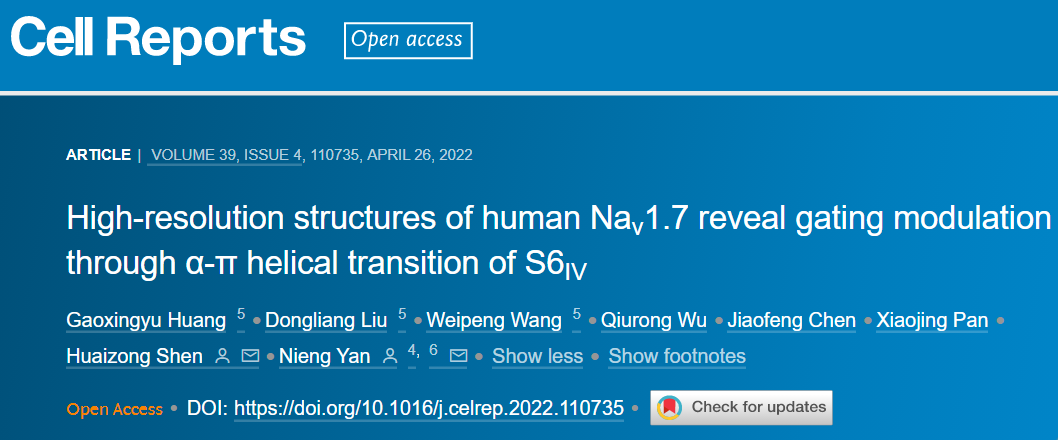Nav1.7 represents a target for the key role of next-generation analgesics in pain perception.
On April 26, 2022, Princeton University Yan Ning and Westlake University Shen Huaizong joint newsletter published a research paper titled "High-resolution structures of human Nav1.7 reveal gating modulation through α-π helical transition of S6IV" at Cell Reports, which studied the work related to β1 and β2 The 2.2-Å resolution cryo-EM structure of the subunit composite Wild Type (WT) Nav1.7 reveals several previously illegible cytoplasmic fragments. Frozen EM data from the reported Nav1.7 (E406K) structure bound to various toxins identified two different conformations of S6IV, one consisting only of α helix angles and the other containing π helix angles in the middle. The ligand-free Nav1.7 (E406K) measured at 3.5-Å resolution has the same structure as the WT channel, confirming that the binding allosterization of Huwentoxin IV or Protoxin II to VSDII induces α → π transitions in S6IV. This local secondary structural shift has a significant impact on pore domain (PD) gating and reshapes the adaptation site of the rapidly inactivated radical sequence Ile/Phe/Mel (IFM).

In summary, the high-resolution structure of human wild-type Nav1.7 provides an accurate template for further biophysical and computational analysis that could aid in drug discovery. Conformational changes after binding peptide-gated modified toxins (GMTs) reveal the GMT's mechanical understanding of allosteric regulation of pore-gated.
On April 27, 2022, Princeton University's Yanning team published a research paper titled "Structural basis for pore blockade of human voltage-gated calcium channel Cav1.3 by motion sickness drug cinnarizine" online at Cell Research. The study found that the structure of the human Cav1.3 channel bound to cinnarizine revealed direct porosity blockade of LTCC by motion sickness drugs. Local structural changes in the cinnamizine binding site lead to axial rotation of the subsequent spiral segments. The α → π transition of the gated residue localization helix angle in S6III further shrinks the ion permeation hole. The structure shown here, along with previous studies, revealed molecular details of the different Cav channel regulator MOAs and laid the groundwork for structurally assisted drug discovery.
Voltage-gated sodium (Nav) channels control membrane excitability in neurons and muscle cells. Of the nine Nav subtypes, Nav1.7, encoded by SCN9A and expressed primarily in dorsal root ganglion neurons, is a promising drug target for pain relief. The high-resolution structure of Nav1.7 will help develop the next generation of analgesics.
In this study, the disease variant Nav1.7 (E406K) was used due to its enhanced level of recombinant expression. The guanidine blockers tetrodotoxin (TTX) and stone clam toxin (STX) were combined with peptide-gated modified toxins (GMTs) prototoxin II (ProTx-II) and tiger stripe toxin IV (HWTX-IV), respectively, both of which inhibited Nav1.7 activation. Two sets of toxin mixtures were added to the purified Nav1.7-β1-β2 complex for structural analysis using single-particle cryo-electron microscopy (cryo-EM).
Although TTX and STX are resolved to the atomic level, GMT is only considered a speck of density. One HWTX-IV is combined with the voltage sensing domain in the second repetition (VSDII), and the two ProTx-II are associated with VSDII and VSDIV, respectively. A weaker density that may belong to ProTx-II can be seen attached to the outside of the cell of the VSDI. Although these binding sites are consistent with previous features, the channel is inactive rather than the resting state that is best suited to accommodate these GMTs.
Although the resolution of GMT is low, a slight variation of VSDII is observed between the two structures. The researchers reasoned that the ligand-free structure of Nav1.7 was needed as a reference for studying the mode of action (MOA) of these GMTs. In addition, it is unclear whether the E406K point mutation has any effect on the conformation of the channel.
Article pattern diagram (from Cell Reports)
With these issues in mind, an attempt was made to address the high-resolution structure of Wild Type (WT) Nav1.7, which could provide an accurate template to aid research and drug discovery. The study also addressed the structure of Nav1.7 (E406K) without any toxins as a control. The structures of the ligand-free Nav1.7-WT and Nav1.7 (E406K) were obtained at 2.2 and 3.5 Å resolutions, respectively, and the updated structures of Nav1.7-PT and Nav1.7-HS revealed a α → π spiral of S6IV after the combination of ProTx-II or HWTX-IV. This local secondary structural shift has a significant impact on pore domain (PD) gating and reshapes the adaptation site of the rapidly inactivated radical sequence Ile/Phe/Mel (IFM).
In summary, the high-resolution structure of human wild-type Nav1.7 provides an accurate template for further biophysical and computational analysis that could aid in drug discovery. Conformational changes after binding peptide-gated modified toxins (GMTs) reveal the GMT's mechanical understanding of allosteric regulation of pore-gated.
Informational messages:
https://www.cell.com/cell-reports/fulltext/S2211-1247(22)00496-X
https://www.nature.com/articles/s41422-022-00663-5